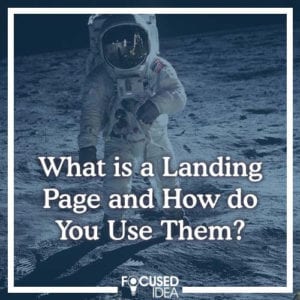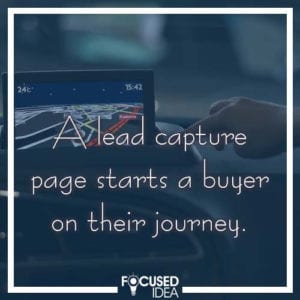What is a Landing Page and How do You Use Them?
So you want to know what a landing page is? In this post, we’ll answer that question and reveal a few tips and tricks for your lead capture pages. The best part, you don’t need to be a professional marketer to figure this out. And with the quick information provided in this post, you can quickly create a landing page that converts again and again and again.
What is a Landing Page?
 When it comes to digital marketing, a landing page (also called a “lead capture page”) is a standalone web page explicitly created for a marketing or an advertising campaign. Unlike a traditional web page, which usually has several objectives and encourages exploring, landing pages are built with a single goal or purpose, known as a call to action (or CTA, in short). This emphasis makes landing pages the best choice to increase your marketing campaign conversion rates and reduce the cost of getting a lead or sale.
When it comes to digital marketing, a landing page (also called a “lead capture page”) is a standalone web page explicitly created for a marketing or an advertising campaign. Unlike a traditional web page, which usually has several objectives and encourages exploring, landing pages are built with a single goal or purpose, known as a call to action (or CTA, in short). This emphasis makes landing pages the best choice to increase your marketing campaign conversion rates and reduce the cost of getting a lead or sale.
A landing page is a destination page made for a specific audience with a specific goal ‐ think, one page, one purpose. A landing page should have a definite call-to-action and eliminate any opportunity for your audience to be distracted. And because of the laser focus of a landing page, successful landing pages lead to better conversion rates, increased engagement, and higher quality leads. They take away distractions that don’t directly point towards your conversion goal.
- Are landing pages necessary if you have a home page? Yes!
- Should you use lead capture pages even if you already have a great Web site? Absolutely.
- Should you use landing pages even if you don’t have a high volume of website traffic? Most definitely.
Wait a Minute! Can’t Any Page Be A Landing Page?
Sure, theoretically. In Google Advertising and Analytics, for example, the word is used this way. All destination pages, however, are not made equal. We use the word “landing page” to describe a campaign-specific page with only one single call to action and no navigation to the website.
Although the homepage has several possible distractions, instead of links, you can effectively call them ‘leaks.’ A landing page is highly focused. Using fewer links on your lead capture page boosts conversions since are less alluring clickables that might send visitors away from your call to action. That’s why practiced marketers invariably use a dedicated landing page as their traffic destination.
Your homepage looks great, of course. It shows off the brand, encourages people to experience a variety of items, and provides additional information about your business and its values. A visitor may go anywhere from here, apply for a job, read some press releases, check the terms of service, post on the forum, etc. But they won’t actually buy anything. And that, ultimately, is the point.
A lead capture page for your customer provides an entirely different purpose. Matched with super slick ads that promote a single offer, everything about it works hard to convert visitors into customers. It will do a better job of converting the traffic the brand’s already getting. That’s the strength of lead capture pages!
Two Types of Landing Page
There are two basic types of landing pages. Each one is used depending on your goal. The first type is called a Lead Generation Landing Page. The purpose of this lead capture page is to collect leads for your business. Now you get a lead generation page in two ways, depending on the audience you are targeting and where the audience is in the buying process. Suppose someone is in the research phase of the buying process. In that case, you should offer some type of downloadable content that is educational in nature and provides value. Things such as ebooks, checklists, and webinars work very well for our clients.
Providing value creates a win-win scenario for you and your potential customer. They get answers to their questions, and you get brand awareness, recall, and contact information. Typically, their email address.
Suppose your audience is in the purchase phase of the buying process. In that case, you should be direct on your lead capture page, identifying the problem, establishing your company as a solution, and asking for contact information through your call to action. This also creates a win-win scenario for you and your customer. They find a solution that can help them, and you get the opportunity to gain a customer once you follow up.
 The second landing page category is called a Click-Through Landing Page. This one is more prevalent among e-commerce, course, and SaaS companies because they don’t try to capture a lead. Instead, the call-to-action button takes them right into the checkout flow – the purchase.
The second landing page category is called a Click-Through Landing Page. This one is more prevalent among e-commerce, course, and SaaS companies because they don’t try to capture a lead. Instead, the call-to-action button takes them right into the checkout flow – the purchase.
Characteristics of a High-Converting Landing Page
Now that you know the two types of landing pages let’s discuss common characteristics of a high converting landing page.
- First, navigational menus are removed. As mentioned previously, high converting lead capture pages focus on one goal – your call to action. To help achieve this goal, remove the navigation from your lead capture page and encourage visitors to stay focused and avoid clicking elsewhere.
- Second, keep your call-to-action buttons above the fold. That’s the top part of a web page as visible without scrolling. You also want to have a call-to-action at the bottom of the page. Why would you do this? Some people come ready to move forward with your CTA. We want to give them that option. The same thing is true for anyone who needs more information and scrolls to the bottom of the page. So you should also place the CTA at the bottom of the page. So those that make it there can move forward with your call to action.
- Third, the call-to-action button’s text should indicate what will happen next, or the end result of taking action.
Think of your CTA button as a GPS. Most people don’t travel along a road unless it takes them to a pre-determined destination. Use your CTA button to clearly state what will happen as a result of clicking it. Standard CTA text includes “sign up,” “join now,” “schedule a call,” and others that have more guidance than a simple “click here.”
There you have it, a clear understanding of what a landing page is, the types of lead capture pages there are, and the characteristics of a high-converting landing page.
If you have any questions or have other landing page tips, please leave a comment below.

